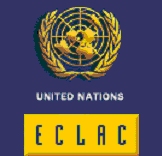The United Nations Economic Commission for Latin America and the Caribbean (UN-ECLAC) says growth in private sector credit is expected to be moderate as a result of the new parliamentary dispensation which it said may lead to uncertainty about government’s policy agenda.
The body also projects that the budget deficit in Guyana will widen because of higher capital spending and could be as high as 6 percent in 2012.
This was disclosed in a new report by ECLAC, entitled ‘Preliminary Overview of the Economies of Latin America and the Caribbean 2011’, and dated December 21, 2011.
 It said that in the first half of 2011, credit to the private sector continued to expand but at a slower rate relative to the corresponding period in 2010.
It said that in the first half of 2011, credit to the private sector continued to expand but at a slower rate relative to the corresponding period in 2010.
It said that central government credit declined while private-sector credit grew by 6.7 percent.
“In 2012 there will be moderate growth in credit to the private sector in view of the uncertainty as to whether the ruling party, with a reduced parliamentary majority, will be able to maintain all aspects of its policy agenda,” the report said.
The government has 32 seats in Parliament while the combined opposition has 33 seats.
The opposition has already signalled that it will press for several key government projects to be reviewed.
The report said that because of the Government’s investment into the Amaila Falls Hydro Electric Project, the budget deficit is anticipated to be 3.5 percent of GDP in 2011 but may be as high as 6 percent in 2012.
It noted that in the first half of 2011, Guyana received some US$32.2 million in debt relief through the Multilateral Debt Relief Initiative, International Monetary Fund (IMF), the International Development Association and the Inter-American Development Bank (IDB). It said that debt servicing will be higher in 2011 and the debt-to-GDP ratio will also increase due to borrowing for investment purposes.
The ECLAC publication said that the monetary policy that the Bank of Guyana has pursued in 2011 continued to focus on stabilizing prices and ensuring sufficient liquidity in the banking system.
It said that the exchange rate was relatively stable in the first half of 2011 with a marginal devaluation of $0.25 Guyana dollars to reach G$203.5 to the US$.
“The foreign exchange market is expected to remain stable in 2012 since inflows of foreign exchange should be adequate,” the document said.
ECLAC noted that in the first half of 2011, the economy posted growth of 5.9 percent but that in the second half, growth was less robust and the overall figure for 2011 will be around 4.8 percent. “Growth of 4 percent is projected for 2012, driven mainly by buoyant commodity prices and increased production of gold, bauxite and alumina, along with agricultural crops such as rice and sugar,” the report said.
ECLAC said that inflation for 2011 will approach the target rate of 4.8 percent. “For the first half of the year, it stood at 2.97 percent but should abate in the second half as food price inflation subsides,” the report said.
It said that employment in the public sector recorded a marginal decline of 0.89 percent, which reflected a 1.67 percent downturn in central government accounts.
“Meanwhile, preliminary estimates for 2011 suggest an increase in private sector employment especially in the areas of construction and wholesale and retail trade. Employment is likely to pick up in 2012 with the start-up of a number of public-sector capital projects,” ECLAC said.





